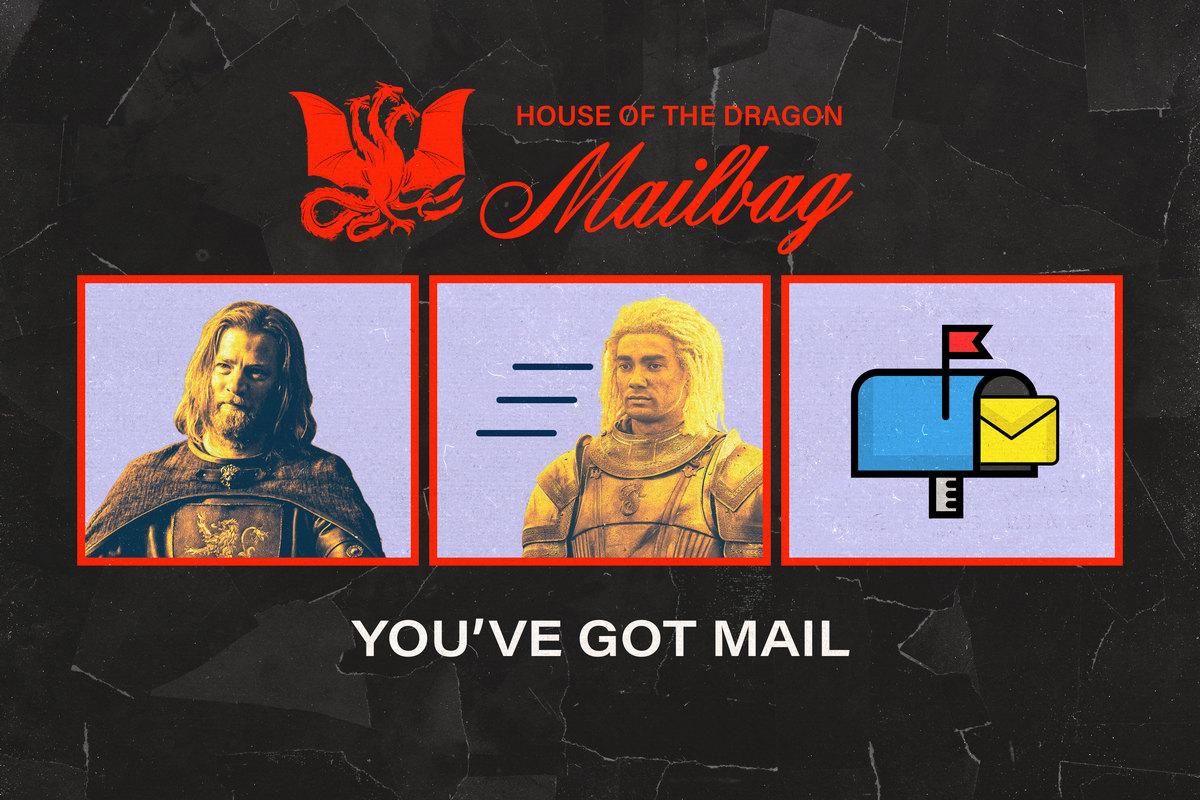‘House of the Dragon’ Episode 3 Mailbag: Deus Ex Dragon
Spoiler-free answers to questions about a new dragonrider’s arrival, the Crabfeeder’s campaign, the lack of technological advancement in Westeros, and more
The House of the Dragon mailbag is back for week three, with a new set of questions about the most recent episode: Why is there a “Jason” in a family of Tylands and Tywins and Cerseis? Where’s the humor on this show? And why does the technology in this prequel look the same as the technology in Game of Thrones, which is set 170 years later?
We’re answering your questions every week that Dragon airs, so be sure to send your raven messages to @zachkram on Twitter or zach.kram@theringer.com. Let’s feast on this week’s selection—starting with the identity of Dragon’s newest dragonrider.
Felurian wants to know “why Viserys allows another house to have a dragon. Isn’t this a potential threat to Targaryen power?”
I received a few questions about the dragonrider who appears at the end of the episode. That’s Laenor Velaryon, son of Corlys Velaryon and Rhaenys Targaryen, and he’s riding a new dragon named Seasmoke. He brings the current count of dragonriders to four:
- Rhaenyra, atop Syrax
- Daemon, atop Caraxes
- Laenor, atop Seasmoke
- Rhaenys, the Queen Who Never Was, atop Meleys
That will be a handy list to monitor as the count grows, given that the creators say nine dragons are coming this season alone.
As to your question, I suppose it’s theoretically possible that Laenor could prove a threat to Targaryen rule. After all, at least in the Fire & Blood source text, Laenor himself was once up for the throne, when the Great Council convened and eventually chose Viserys instead. And if the realm were to fall into civil war at this very moment, Laenor’s side might even be favored to win in battle: It wouldn’t boast nearly the manpower that Viserys could muster, but it would have multiple dragonriders (Laenor; Rhaenys, his mother; and possibly Daemon, his ally in the Stepstones) against only Rhaenyra. Lyonel Strong’s suggestion that Rhaenyra marry Laenor to help bring unity isn’t completely farfetched.
Realistically, though, there’s little chance that Laenor or anyone with dragons would rebel against the Targaryens. That’s because every rider is at least half-Targaryen, including Laenor through his mother. It’s not as if random Lannisters or Starks are flying around on dragons, too.
In actuality, it’s unclear whether those houses could even ride dragons without Targaryen intermarriage. All known riders, both at this point and throughout Westerosi history, can trace their ancestry back to old Valyria, where the dragons themselves originated. Of the four dragonriders in the show, Rhaenyra has a Targaryen father and half-Targaryen mother, Daemon has two Targaryen parents, Rhaenys has a Targaryen father, and Laenor has a half-Targaryen mother and Velaryon father. (Velaryons also come from Valyria, though they never rode dragons before mixing with the Targaryens in Westeros.)
The obvious question is whether Valyrian ancestry is required to ride a dragon—but the answer is unknown. Even Thrones never fully explored this question, because the only attempted riders were a known Targaryen (Daenerys), a secret Targaryen (Jon), and the Night King after resurrecting a dragon. In the book series, we still await the answer—can the Dragonbinder horn help Euron or Victarion Greyjoy command a dragon?—but for now, it’s safe to assume that no non-Targaryen families will be able to compete with Targaryen rule in the skies.
Now, if one Targaryen were to rebel against another Targaryen who sat the Iron Throne, and threaten power that way, that might be a different story …
Matt asks, “So if the Crabfeeder was holed up for 2-3 years in caves with his men, resisting Daemon, Corlys, and the rest, wouldn’t that solve the problem of him dominating the Stepstones that brought Daemon to war in the first place?”
To review: At first, Westeros essentially welcomed the Crabfeeder to the Stepstones because he cleaned out the assorted pirates who used the Stepstones to harry shipping routes across the Narrow Sea. But then the Crabfeeder’s own forces began acting like the pirates they’d replaced, which necessitated intervention. If the presence of a dragon could send the new foes into hiding, then the shipping lanes would be free and clear.
Yet I fear that solution would have only been temporary: As soon as the dragons would have left, the Crabfeeder would reemerge. So if Daemon and Corlys hadn’t the war outright, Daemon or another dragonrider would have had to spend the rest of their life serving as the equivalent of a security guard for merchant ships. And even dragons can’t stay aloft forever.
Still, this is an astute point—and fits with my broader critique that the time jump in “Second of His Name” muddles our understanding of the war in the Stepstones. How exactly is the Crabfeeder winning, even with caves on his side? Away from his home in the Free Cities, he presumably has limited men, food, and resources, and Daemon’s raid at the start of the episode seemed mighty effective even if the enemy leader didn’t die in the flames.
But if it seems that the war in the Stepstones wasn’t impeccably plotted, that might be because, in the book, it’s not. Fire & Blood spends just a single paragraph detailing the entire course of the war against the Crabfeeder:
It is not our purpose here to recount the details of the private war Daemon Targaryen and Corlys Velaryon waged on the Stepstones. Suffice it to say that the fighting began in 106 AC. Prince Daemon had little difficulty assembling an army of landless adventurers and second sons, and won many victories during the first two years of the conflict. In 108 AC, when at last he came face-to-face with Craghas Crabfeeder, he slew him single-handed and cut off his head with Dark Sister.
In fact, this answer has used the word “Crabfeeder” more times than the entire A Song of Ice and Fire corpus does. I was surprised that Dragon appeared to build up his character and his battle as such a focal point, given the abrupt ending that was sure to ensue. I guess the showrunners felt the pressure to add an action scene amid the King’s Landing politics early on.
DFives asks: “So like, Kevan Lannister is definitely the grandson of Jason Lannister, right? Like there’s just the one specific line of Lannisters with names like Steve, Kyle, and Frank. And they’re the Lannisters that the other Lannisters look down on.”
Can I also introduce you to a Lannister named Tyler? (OK, his last name was Hill because he was the Lannister lord’s bastard rather than a trueborn son, but the thought still counts. I also think Tyler Hill has a chance to make the USMNT’s World Cup roster.)
If you, like Mina Kimes’s father, want more conventional names on Dragon, however, you might be out of luck in the near future. There’s a small chance that a mythical character named Sara will appear at some point, but otherwise, all the new characters we’ve yet to meet will either have highfalutin fantasy names or fit the George R.R. Martin move of giving a “normal” name a spelling skew, as is the case with Kevan Lannister. A Qarl and Jeyne will emerge, and an Arryk and Erryk (they’re twins!), and perhaps an Alys as well.
Most importantly, though, this question gives me the opportunity to introduce you to the family with by far the most fun names at this time in Westeros’s history. Remember the Tullys, Catelyn Stark’s family, lords of the Riverlands? In the Thrones era, they all had typically archaic names: Catelyn’s father was Hoster, her uncle was Brynden, and her brother was Edmure. (Edmure, you might recall, was the unlucky groom married at the Red Wedding.)
Well, rewind 170 years and you’ll notice a different pattern in the Tully nomenclature. The lord of Riverrun at the time is named Grover Tully. His grandson is named Elmo. And Elmo’s two kids are named Kermit and Oscar.
The Muppet Tullys aren’t relevant to the Targaryen civil war until later, so I’m not sure when they’ll enter the story—but I can’t wait until they do.
Tom asks, “Why won’t they let Paddy Considine be funny?”
Considine plays King Viserys, and I found his reaction to Otto’s proposal that Rhaenyra be betrothed to 2-year-old Aegon funny, at least. His “Do you have dragons to offer?” putdown of Jason hit the spot, too. But I agree with the critique more broadly: Compared to Thrones, Dragon is missing the humor.
This absence stems in part from the source material. Thrones was adapted from actual novels, while Dragon comes from a history book with scant dialogue. Fire & Blood does include some clever quips and one-liners—assuming the show uses them, there are some bangers coming later in Season 1—but almost no full conversations, which means no banter to pull from the page.
Also hurting banter is the lack of friendships on the show, especially with a rift rising between Rhaenyra and Alicent. Thrones mined comedy from Robert and Ned, and from Arya and the Hound, and from Tyrion and Bronn. Thus far, however, Dragon hasn’t found the pairings that compel—particularly those that crossed social strata, like Arya and the Hound or Tyrion and Bronn.
The absence of a Tyrion character looms large, and there probably isn’t any Dragon character who can replace his consistent comedy. But it might be premature to conclude that every character will be this serious throughout the show’s duration; humor could develop organically, particularly with side characters, as it did in Thrones.
Other than Tyrion, much of Thrones’ humor came from these supporting players, like Bronn and Olenna Tyrell. The show even leaned into this discovery at times, giving characters like Bronn and Tormund bigger roles than they have in the books to better balance their levity against the show’s overwhelmingly gritty drama. One might argue they veered too far in this direction—the Tormund-Brienne courtship was a bit much—but I prefer it to the alternative. Let’s see if Dragon adapts as well, as the time jumps slow and the show finds a more comfortable rhythm.
Mark asks: “Has the realm failed to advance technologically in the 170 years which elapse between HoD and GoT? What explains this stagnation?”
We’ll end this week’s mailbag with a dissertation, because, Mark, you have no idea how many years I’ve been thinking about this question. There are some examples of new technology in Thrones, suggesting advancement from the Dragon era. For instance, Tyrion helps create a new saddle for Bran, after the latter is paralyzed below the waist, and in the show, Samwell Tarly employs an unorthodox medical procedure when he saves Jorah Mormont from the supposedly incurable greyscale (via the very advanced method of … just scraping most of his skin off). But these cases are few and far between.
Moreover, your question only gets at the tip of the iceberg. Westeros hasn’t just failed to advance technologically in the 170-year span we’ve seen on TV; it basically hasn’t advanced for the thousands of years documented in Martin’s stories about the realm. Drop ancient heroes like Bran the Builder and Lann the Clever into Westeros’s “modern” day, and existing evidence suggests they’d be able to function in a way that, say, Queen Elizabeth I or Julius Caesar could not in real-world present-day society.
The actual answer is probably boring: Martin most likely wanted to write in a medieval setting and keep writing in a medieval setting even as his story spanned millennia, so he decreed that Westeros’s tech wouldn’t mature. There are exceptions—including The Legend of Korra, which pushes tech forward from the Avatar: The Last Airbender days, and Joe Abercrombie’s First Law universe, which belongs to Martin’s grimdark fantasy genre—but it’s not easy to weave logical large-scale development into a fictional world.
Yet to Martin’s credit, his fictional world also inspires several in-universe theories for the lack of advancement. I’ll go through five of my favorites here.
First, progress isn’t linear. Our real world has changed an incredible amount in the 170 years since 1852—but it changed a lot less from, say, the years 852 to 1022, or, for that matter, for massive swaths of human history before that. As our technology advances, our rate of change advances, too, but Westeros might still be stuck in a period of flatter growth.
A second factor could be Westeros’s feudal political system, which discourages innovation because folks are mostly stuck in the economic class of their birth no matter how much they produce. Westeros also features very few urban areas, and it hasn’t seemed to exhibit much population growth—both key drivers of progress—over the centuries since it was settled.
This is a bit of a chicken-and-egg problem—is Westeros’s technology stagnant because its population is stagnant, or vice versa?—but for a counterexample, consider Braavos, which has a more modern, capitalistic culture. Whether it’s correlation or causation, Braavos also happens to boast “unprecedented” engineering abilities, the World of Ice and Fire encyclopedia says: While Westerosi ships take a tremendous amount of time to construct, Braavos has yards that can build a full warship in a day. Moreover, Braavos’s Iron Bank displays a level of financial sophistication far beyond anything across the Narrow Sea.
A third important factor that limits Westeros’s progress is its frequency of debilitating winters, which to some extent force society to reset every few years. This factor relates to the population problem, of course, but it also matters in its own right: How are people supposed to focus on improving the medium-term future when they’re so focused on stocking food for the winter that’s right around the corner?
The fourth potential problem is maester meddling, because men of the Citadel control the continent’s education system and seem incredibly stuck in their outdated ways. They disapprove of Qyburn and his experiments, for instance. (They may have had a point in his case—but Qyburn is the only maester in the entire series who seems to care about scientific inquiry.) They also disapprove of Sam’s (ultimately successful) greyscale venture. The maesters don’t seem to want progress, so it’s not hard to imagine how possible breakthroughs might be stymied by the few learned men of the realm.
The fifth and final theory, which I find among the most compelling from a fantasy storytelling perspective, is that the existence of magic in this world once limited the need for tech, which then cast an overall dampening effect on progress. Think about how the wizards in Harry Potter don’t know how to drive or use the subway even in the 1990s—why would they have learned, when they can travel by so many more efficient magical means?
Magic isn’t as commonplace in the Seven Kingdoms as it is in Potter, but it came close, once upon a time, and helped build architectural wonders like the Wall and (probably) the Hightower of Oldtown. “Modern” characters like Jon Snow couldn’t hope to replicate those efforts and build the Wall now. And magic began to fade from this world only relatively recently, so perhaps—due to all the other factors mentioned above—the realm hasn’t had the time and opportunity to adjust to the new normal and start inventing technological replacements. The Doom certainly doesn’t help, because the destruction of the once-great civilization of old Valyria means would-be Westerosi scholars can’t (and may be afraid to) study the past in the same way that medieval Europeans learned from ancient Rome.
Will we ever learn a definitive answer to this question? Probably not. But this sort of deep, philosophical world-building question is among the most fun to explore in a story like Martin’s, which is blessed with such rich, vast lore.


